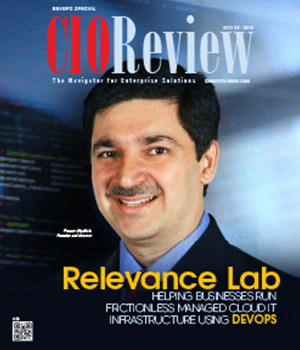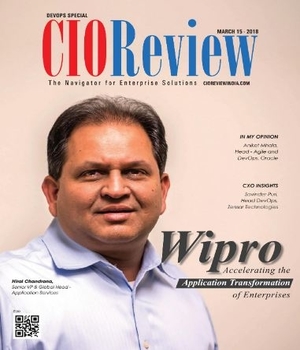
Using Containerization to Simplify DevOps Infrastructure
Janifha Evangeline | Sunday, 30 April 2023, 16:56 IST

Containerization is gaining popularity since it is a great method of application packaging and offers a workable answer for automating IT provisioning procedures. DevOps teams can be empowered by containerization to concentrate on their most critical objectives, with administrators setting up containers with the necessary dependencies and configurations and developers writing effective code for rapid and simple application deployment.
Container-based Automation is made possible by platform as a service or pure container as a service solution, which also have the added advantages of reducing human error, accelerating time to market, and improving resource utilization.
Low TCO due to advanced isolation of system containers that allow running different types of applications on the same hardware node, reusing unused resources for other containers on the same host, and optimized memory and CPU usage based on the current load with automatic vertical scaling that doesn't require restarting while changing resource limits. High application density and maximum utilization of server resources compared to virtual machines. Some of the key methods of using containerization in the process of simplifying DevOps infrastructure include the following:
Assessing Current project needs
For novices in particular, making the most of containerization for DevOps necessitates careful consideration of a few major roadblocks. We will go through a few of the things that need to be taken into account while developing and putting into practice a containerization strategy below.
DevOps teams must first carefully evaluate the state of their projects in order to decide what needs to be done in order to switch to containers and reap their sustainable, long-term benefits.
The misconception that containers are only appropriate for new applications (microservices and cloud native) is common. However, using containers allows monolithic and legacy applications to change and begin anew. Just making sure the right kind of container is chosen is crucial.
One process can be executed within an application container (like Docker). They are frequently a preferable option for new projects because it is very easy to construct the necessary images using publicly available Docker templates while taking into account microservice patterns and needs for current infrastructure design.
Like a full-featured OS, a system container like LXC, OpenVZ, or Virtuozzo may operate full-featured unit systems and spawn additional processes. As it allows for the reuse of the architecture and configurations that were implemented in the original VM-based design, the structure will largely remain the same, this type is preferred for monolithic and legacy applications.
Building Expertise
Moving from virtual machines to containerization is a challenging shift. To attain the efficiency, flexibility, and success that containerization may bring, your operations team will need to get familiar with the major differences between these two drastically different approaches.
When it comes to effective containerization in the cloud, conventional operations knowledge is no longer relevant. Now that infrastructure hardware and network management is frequently provided by cloud providers, DevOps teams must manage their automated software deployment strategy through scripting and the use of containerization tools geared towards containers.
System integrators and consulting firms can share their expertise with you and support you while you reap the rewards of containers. The ideal course of action, however, if you want to manage the entire process internally, will be to cultivate in-house expertise – engage knowledgeable DevOps specialists, research best practices, and create a new knowledge base.
Additionally, because enterprise-wide container adoption can be a gradual process, it is essential for large organizations to choose a solution that manages heterogeneous types of workloads using virtual machines and containers on a single platform.
Ensuring Security
Environments in containers are far more flexible and able to change quickly than those in virtual machines. This mobility is a major benefit of containers, but it can be difficult to guarantee the proper level of security while also giving the necessary quick and easy access for developers.
As you implement a containerization strategy, you must assess the particular security risks that your company faces in order to protect your confidential information and data. Additionally, when calling internal components inside a microservice application, you must keep in mind that basic container technology does not easily work with interservice authentication, network configurations, partitions, and other matters regarding network security.
Containers appeal to DevOps teams because they enable them to maintain the same set of tools for both development and production, ensuring crucial consistency that minimizes errors and saves time. Additionally, they are infrastructure-independent, allowing them to function in a variety of settings. Teams can collaborate more quickly and create a culture of experimentation and openness when organizational procedures are auditable and reproducible. Additionally, IT teams can spot inefficiencies and change priorities more quickly.
The containerization strategy often produces smaller instances than Virtual Machines. Additionally, it makes for quicker app deployments because the smaller, lighter images need less time to launch.
Because of these traits and the fact that containers establish environment-independent states, DevOps teams may work on projects faster and with less mental strain. Containerized development supports convenient isolation in a world where micro services are progressively taking over. Moving quickly without wrecking anything is made simpler by this. Some of the examples of organizations that implemented Containerization in their processes include Spotify, GitLab and others
Early on, Spotify realized the importance of containers. In 2013, when Docker was still in its infancy, the audio streaming company started employing containers and had even created its own internal orchestration system, dubbed Helios. Software developer Matt Brown from Spotify told Google Tech Cloud that the business open-sourced Helios one day before Kubernetes was introduced. Shortly after, Spotify started the switch to Kubernetes.
According to site reliability engineer James Wen, the change reduced the time it took to set up a host for a new service from an hour to minutes or seconds and tripled CPU utilization. Recently, Spotify created Backstage, an open-sourced developer site with a Kubernetes monitoring system.
Given that both GitLab and Kubernetes are essential components of the DevOps toolset, GitLab has cited Kubernetes adoption as one of the "biggest tailwinds" fueling long-term growth for its business, along with things like remote work and open source.
In 2020, Marin Jankovski, director of platform infrastructure at GitLab, provided some statistics on the company's infrastructure size, performance, and deployment speed following the switch from traditional virtual machines to containers. In other words, fewer machines are needed to run programmes quicker. According to Jankovski, workloads are distributed over three nodes instead of 10, processing units are three times faster, and deployment speeds are 1.5 times faster.
To make adoption easier, there is a wide range of technological solutions for container orchestration. To maximise the benefits of this strategy and guarantee your company's long-term DevOps success, the most crucial component of containerization for DevOps is a competent team of individuals who are familiar with container-specific best practises.
CIO Viewpoint
By Anand Kapoor, SVP - Data & Insights at Antuit
Whats The CIO Got To Do With The IOT?
By Sharon Gietl, VP Of Information Technology and CIO , The Doe Run Company
By Zuzar Tinwalla, CIO, Standard Charted Bank India
CXO Insights
Real-Time Engagement (RTE) Technology and its...
By Janifha Evangeline
EON Reality: Empowering Organizations to Reach...
By Shiva Prasad G, Director, EON Reality India
DevOps, DevSecOps Predictions for 2022








